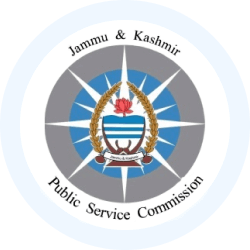JKPSC KAS (Jammu and Kashmir) Exam > JKPSC KAS (Jammu and Kashmir) Notes > JKPSC KAS (Jammu and Kashmir): Preparation Course > Modern History of Jammu and Kashmir
Modern History of Jammu and Kashmir | JKPSC KAS (Jammu and Kashmir): Preparation Course PDF Download
| Table of contents |

|
| Introduction |

|
| Afghan/Pathan Rule in Kashmir |

|
| Sikh Rule in Kashmir |

|
| Dogra Rule in Kashmir |

|
| Emergence of Jammu and Kashmir as an State of Indian Union |

|
Introduction
Following the end of Mughal rule in Jammu and Kashmir during the medieval period, the modern era marked a significant transition for the state. It came under the control of Afghan rulers, Sikh rulers, and Dogra rulers before eventually becoming part of the Indian Union through the Instrument of Accession.
Afghan/Pathan Rule in Kashmir
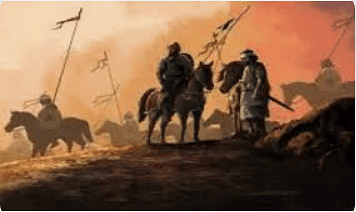
- In the period following Aurangzeb's reign, Kashmir experienced significant turmoil under the later Mughal rulers. These Mughals governed Kashmir through 14 corrupt Governors who engaged in plunder and displayed religious intolerance. In response to this misrule, two Kashmiri nobles, Miri Muquim Kant and Khwaja Zahir Didmari, invited Ahmad Shah Abdali Durrani of Kabul, who was then in Lahore, to capture Kashmir. Abdali agreed and dispatched an Afghan army to take control of the region.
- Afghan rule was established in Kashmir in 1752 and lasted until 1819, following the defeat of the Mughal Governors.
- The 67 years of Afghan rule are often regarded as the darkest period in the history of Jammu and Kashmir. Afghan rulers and their Governors inflicted severe cruelty on the populace. Abdullah Khan Aqasi, the first Afghan Governor, instigated a reign of terror, leading to widespread looting and insecurity for the local people.
- Despite this dark period, a Hindu Governor named Raja Sukh Jivan briefly restored peace in Kashmir from 1754 to 1762. However, his efforts were short-lived as he was soon defeated by Ahmad Shah Abdali Durrani. After Abdali's death in 1772, the Afghan Amirs changed frequently, with 28 different Governors serving during the 67 years of Afghan rule. This frequent turnover exacerbated the situation, leading to even greater ruthlessness and exploitation by the Governors. As a result, the Pathan rule in Kashmir is remembered primarily for its brutality and harshness.
- Due to the harsh conditions under Afghan rule, two Kashmiri residents, Pandit Birbal Dhar and his son Pandit Rajakak Dhar, traveled to Lahore and appealed to Maharaja Ranjit Singh to intervene. In response, Maharaja Ranjit Singh dispatched a force of 30,000 Sikh soldiers in 1819 to conquer Kashmir.
Question for Modern History of Jammu and Kashmir
Try yourself:
During which period did Afghan rule take place in Kashmir?View Solution
Sikh Rule in Kashmir
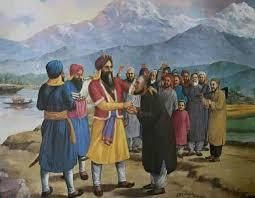
- Following the defeat of the Afghan rulers, Kashmir came under Sikh rule from 1819 to 1846 AD. The Sikhs governed the region for 27 years through a series of ten Governors.
- The first Sikh Governor was Diwan Moti Ram. Due to the distance from Lahore, where the Sikh rulers were based, Kashmir received minimal attention. Natural disasters such as early snowfall and famine, coupled with the rulers' neglect, exacerbated the dire conditions.
- During this period, two British officials from the East India Company, Mr. William Moorcroft (1822) and Mr. Reynell Taylor (1846), visited Kashmir. They observed the severe hardships faced by the people: widespread poverty, starvation, and illness. Many villages were abandoned, and those remaining were struggling with serious health issues. The death of Ranjit Singh in 1839 led to turmoil in Punjab, further complicating the situation.
- In the first Anglo-Sikh War (1845-1846), the East India Company captured Lahore. With the fall of the Sikh Empire in Punjab in 1846, the authority of Sikh Governors in Kashmir weakened. The last Sikh Governor, Sheikh Imam-ud-din, was succeeded by Gulab Singh Dogra, who took the opportunity to annex Kashmir, marking the beginning of a new era in the valley's history.
Dogra Rule in Kashmir
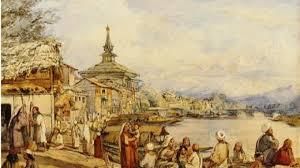
- Sikh Army Chief Gulab Singh, who was granted the title of Raja by Maharaja Ranjit Singh, collaborated with the British Government to secure Kashmir. The Treaty of Amritsar, often referred to as the ‘Sale of Kashmir,’ was signed on March 16, 1846, between the British Government and Maharaja Gulab Singh of Jammu.
- Under the terms of the treaty, Kashmir was sold to Maharaja Gulab Singh for ₹75 lakh. The treaty granted him independent control over the region and its hilly areas, extending from the Indus River in the east to the Ravi River in the west, including Chamba. However, Maharaja Gulab Singh was required to acknowledge British supremacy, pay an annual token tribute, and support British troops when needed.
- After overcoming the resistance of the last Sikh Governor of Kashmir, who had resisted surrendering the province, Maharaja Gulab Singh formally took control of Kashmir on November 9, 1846. He successfully united Jammu, Kashmir, and Ladakh into a princely state of Jammu and Kashmir. Gulab Singh ruled until 1857, during which he established a stable administration and restored peace to the region.
Some of the important rulers of Dogra rule were as follows:
Maharaja Ranbir Singh
- Maharaja Ranbir Singh ascended the throne in 1857 and ruled until 1885. He was the son of Maharaja Gulab Singh. Both Maharaja Gulab Singh and Maharaja Ranbir Singh were instrumental in building the Raghunath temple complex in Jammu, which became a key center for Sanskrit education for Brahmin students. During Ranbir Singh's reign, he annexed the Trans-Himalayan territories of Gilgit, Astore, and Hunza-Nagar, incorporating them into Jammu and Kashmir.
- Maharaja Ranbir Singh also commissioned the Ranbireshvaram temple, the largest Shiva temple in North India, along with other temples in Jammu and Utter Behani. He established the Dharmartha Trust to manage these temples. His initiatives included founding the ‘Daarul Tarjunah,’ a research and translation bureau, as well as promoting education through the creation of a great Pathshala and modern schools. Additionally, he began work on the Banihal-cart road, now known as the Jammu-Srinagar Highway.
Maharaja Pratap Singh
- Maharaja Partap Singh ascended the throne in 1885 AD, succeeding his father, Maharaja Ranbir Singh. During his reign, a British resident was appointed to advise him on important matters.
- Maharaja Partap Singh oversaw the construction of the Jhelum Valley Road and completed the Banihal Cart Road. He also built a bridge over the Tawi River and connected Jammu to Sialkot with a railway line. Additionally, he initiated the digging of two canals, the Ranbir Canal and the Pratap Canal, to enhance irrigation in the state.
- Under his rule, the state saw the establishment of its first hydro-electric project at Mohra, located about 22.5 km from Baramulla towards Uri. Furthermore, municipal committees were formed for the cities of Jammu and Srinagar, marking a step towards modern urban administration.
 |
Download the notes
Modern History of Jammu and Kashmir
|
Download as PDF |
Download as PDF
Maharaja Hari Singh
- Maharaja Hari Singh ascended the throne in 1925 AD, succeeding his uncle Maharaja Pratap Singh. During his reign, he implemented several significant reforms, including making primary education compulsory, introducing laws to prohibit child marriage, and opening places of worship for low castes.
- In 1934, he established the first legislature of Jammu and Kashmir under the Constitution Act of 1934. This legislature included a Council, with the Prime Minister and ministers appointed by him, and an Assembly, known as the ‘Praja Sabha,’ consisting of 75 members.
Administration During Dogra Rule
The administration of Dogra rule in Kashmir was organized as follows:
- Jammu Province: Covered the area from the Ravi River to the Jhelum River, south of the Pir Panjal range. This included the Dugar region and the Mirpur area, which were predominantly Western Punjabi-speaking.
- Kashmir Province: Included the entire Kashmir Valley and the Western district of Muzaffarabad. The Valley was divided into two districts: Anantnag and Baramulla.
- Srinagar: Designated as the summer capital of the State, whereas previously the administration was managed from Jammu.
- Ladakh: Managed by a Thanedar, with notable administrators like Magna, Mehta Basti Ram, and Mehta Mangal introducing modern administration for the first time. Later, Ladakh and Baltistan were merged under a single administrator with headquarters in Leh during the summer and Askardu in the winter.
- Baltistan: Included its main town of Askardu and was initially managed separately by a Thanedar.
- Gilgit: Made a separate administrative unit with its headquarters in Gilgit.
This administrative setup remained in place until the end of Dogra rule in 1947 and India's independence.
Emergence of Jammu and Kashmir as an State of Indian Union
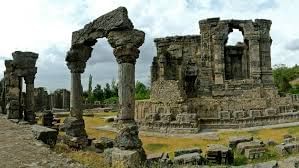
- Following India's independence from British rule and its subsequent partition into India and Pakistan in 1947, the princely state of Jammu and Kashmir, ruled by Maharaja Hari Singh, faced a critical decision. The Maharaja had the option to join either India or Pakistan or to remain independent with certain conditions.
- Due to a revolution by his Muslim subjects and intervention by Pashtun tribesmen from Afghanistan, Maharaja Hari Singh opted to sign the Instrument of Accession to India in October 1947. Consequently, Pakistani troops advanced into the state, and Maharaja Hari Singh sought refuge in India. India responded by sending troops to Jammu and Kashmir and lodged a formal complaint with the UN Security Council in January 1948.
- The conflict was eventually halted with the intervention of the United Nations, which led to a ceasefire agreement in July 1949, establishing the Line of Control (LoC) that divided the state. This division, which is still in effect, separated the state into regions controlled by India and Pakistan.
- In 1949, Yuvraj Karan Singh, the son of Maharaja Hari Singh, was appointed as the Regent of Jammu and Kashmir. The monarchy was abolished in 1952, and Karan Singh became the Sadar-i-Riyasat (Head of State), later serving as the first Governor of Jammu and Kashmir from 1965 to 1967. In April 1951, Karan Singh issued a proclamation to create a Constituent Assembly for drafting the state's constitution. By November 1956, the Constitution of Jammu and Kashmir was adopted and came into effect on January 26, 1957.
- Various proposals were put forward to resolve the Kashmir dispute, but none led to a definitive resolution. This ongoing conflict contributed to the Chinese incursion into Ladakh in 1962 during the Sino-Indian War and led to warfare between India and Pakistan in 1965. This conflict was concluded with the signing of the Tashkent Agreement in 1966.
- Another conflict occurred in 1971, resulting in the creation of Bangladesh. Several other agreements, such as the Shimla Agreement in 1972, were also made, yet the Kashmir issue remains unresolved between India and Pakistan. The Line of Control is frequently breached, and tensions in the valley persist.
Question for Modern History of Jammu and Kashmir
Try yourself:
Which ruler signed the Treaty of Amritsar, also known as the 'Sale of Kashmir', with the British Government?View Solution
The document Modern History of Jammu and Kashmir | JKPSC KAS (Jammu and Kashmir): Preparation Course is a part of the JKPSC KAS (Jammu and Kashmir) Course JKPSC KAS (Jammu and Kashmir): Preparation Course.
All you need of JKPSC KAS (Jammu and Kashmir) at this link: JKPSC KAS (Jammu and Kashmir)
FAQs on Modern History of Jammu and Kashmir - JKPSC KAS (Jammu and Kashmir): Preparation Course
| 1. What were the different rules that Kashmir witnessed before becoming a state of the Indian Union? |  |
| 2. How did Jammu and Kashmir emerge as a state of the Indian Union? |  |
Ans. Jammu and Kashmir became a state of the Indian Union after the Dogra ruler Maharaja Hari Singh signed the Instrument of Accession in 1947.
| 3. What role did the JKPSC KAS (Jammu and Kashmir) play in the modern history of Jammu and Kashmir? |  |
Ans. The JKPSC KAS (Jammu and Kashmir) is responsible for conducting the Kashmir Administrative Services exam, which plays a crucial role in the governance and administration of the state.
| 4. How did the Dogra rule in Kashmir influence its history and development? |  |
Ans. The Dogra rule in Kashmir saw significant infrastructure development and administrative reforms, shaping the state's modern history.
| 5. What impact did the Sikh rule have on the culture and society of Kashmir? |  |
Ans. The Sikh rule in Kashmir led to changes in governance, administration, and cultural practices, influencing the region's identity and heritage.
Related Searches



